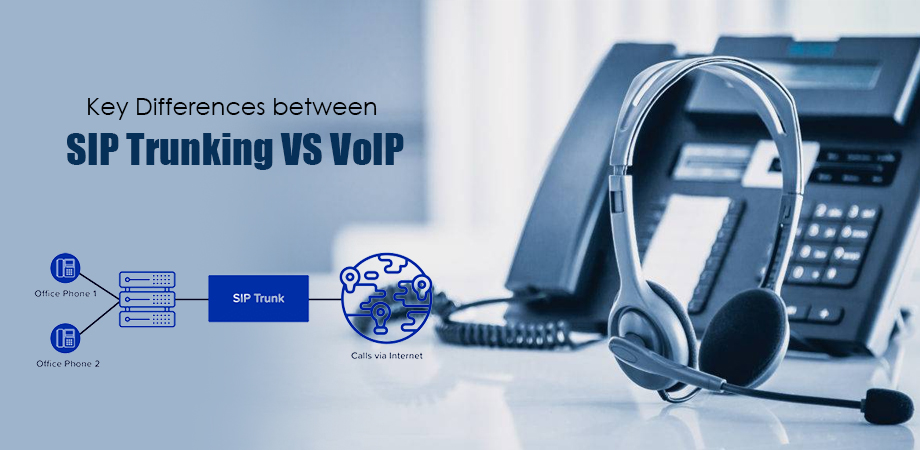
This blog will examine SIP Trunking VS VoIP, key differences, and distinctive features of SIP and VoIP, examine their advantages, and assist you in choosing the communication option that will be most appropriate for your company.
Let’s Have A Quick Overview:
Effective and trustworthy communication is essential for businesses to succeed in the digital age. Due to technological advancements, voice-over-Internet Protocol (VoIP) and Session Initiation Protocol (SIP) have become common options for contemporary communication solutions. The distinction between VoIP and SIP Trunking, however, is sometimes misinterpreted.
What Is VoIP Terminology?
VoIP, or Voice over Internet Protocol, is a term used to describe the transmission of voice communications online. Using internet protocols, it transforms analogue voice signals into digital data packets that are subsequently transferred. VoIP is a cost-effective replacement for conventional phone lines because it aims to enable voice communication via the Internet.
The most important lesson from this is that SIP, the foundational protocol for VoIP functionality, is a subset of VoIP. SIP includes a wider range of communication services than VoIP, which only deals with voice communications.
What Is SIP?
The signalling mechanism, SIP, or the Session Initiation mechanism, facilitates multimedia communication over the Internet. It manages not just voice conversations but also video calls, instant messaging, media distribution, and other multimedia services in addition to voice calls. SIP is a solid option for companies integrating several communication channels since it is more adaptable and expandable than VoIP.
VoIP versus SIP Trunking:
Let's examine the benefits and drawbacks of each to understand better how telcolinellc's SIP Trunking and VoIP differ from one another:
SIP Pros for VoIP:
In the event of a primary internet connection breakdown, VoIP with SIP can offer failover to mobile devices, assuring continuous communication.
- Flexibility: SIP VoIP systems provide a scalable solution that adjusts to shifting business needs by enabling organizations to add choices and lines as needed.
- User-Friendly Administration: SIP VoIP systems have user-friendly administrative tools for adding lines, numbers and altering configurations to make management jobs easier.
- Integrations: SIP VoIP systems can be combined with common office software and apps to increase productivity and streamline processes.
VoIP and SIP Drawbacks:
SIP VoIP systems need a lot of bandwidth to ensure a high level of service, which presents a problem for companies with constrained network resources.
- Variation in Service Quality: There may be discrepancies in the call clarity and dependability provided by SIP suppliers.
- Quality and Security issues: Using public web services to transmit SIP VoIP traffic rather than dedicated fibre-optic connections may increase quality and security issues.
The Advantages of SIP Versus VoIP
VoIP and SIP have benefits, but SIP has extra features that can greatly improve business communication.
- Cost-Effectiveness: Cost-effective options for organizations are provided by SIP Trunking, which has lower line rental rates and lower call expenses for local, mobile, national, and international calls.
- Scalability: Without costly hardware installations or high costs, SIP providers can quickly grow the size of office phone networks.
- Reliability: For seamless communication, a reputed SIP provider can guarantee dependable service with the greatest Quality of Service (QOS).
- Redundancy and Disaster Recovery: Compared to conventional PSTN or ISDN services, SIP provides more re-routing possibilities for redundancy, ensuring continuity in the event of network outages.
Choosing VoIP and SIP Wisely for Your Business:
Recognizing that SIP is the underlying protocol that makes VoIP capabilities possible when contrasting SIP Trunking with VoIP is critical. Since SIP is the engine that powers VoIP, there isn't a rivalry between these two.
SIP Trunking is the top option for companies looking for a reliable and adaptable communication solution. SIP gives organizations the tools to optimize their communication channels and boost overall productivity because of its capacity for handling multimedia communication, scalability, affordability, and independent network access.
Read more: What is VoIP traffic: Explore everything about VoIP
Additional Note to Consider:
Any firm must have effective communication if it is to succeed. While SIP Trunking and VoIP have benefits, SIP is more appealing for contemporary enterprises because of its adaptability and scalability. Businesses can enjoy smooth communication, increased reliability, cost savings, and a full range of multimedia communication services by selecting a reputable SIP supplier like Bulk Solutions.
So, if you're thinking about updating your communication infrastructure, use SIP Trunking wisely to stay ahead in the world of digital commerce. Moreover, it would help to remember that quality and dependability are essential. Bulk Solutions is ready to meet your telecommunication demands while upholding the highest standards.
Wrapping up:
Going through the blog post above, you can learn some major differences between VoIP and SIP and clarify SIP Trunking VS VoIP. If you are still searching for additional information, you must refer to the official telcolinellc support page.
Please take a look at our website from time to time!
